- +91 9435637641 / 7099895338
- moc.yrevocsidivrup@yrevocsidivrup
- Purvi Gallery
- Guest Comment
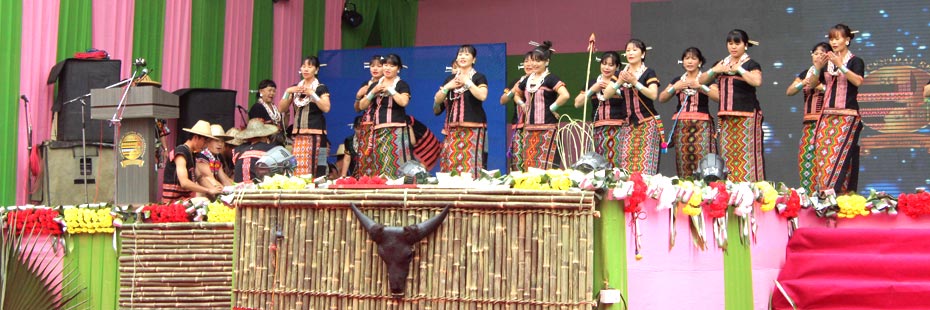
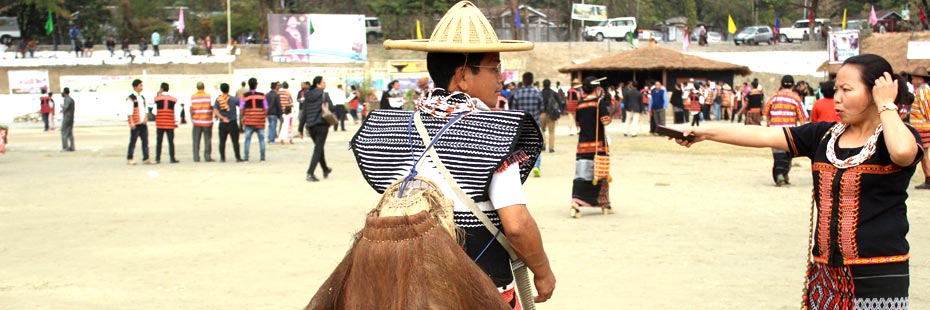
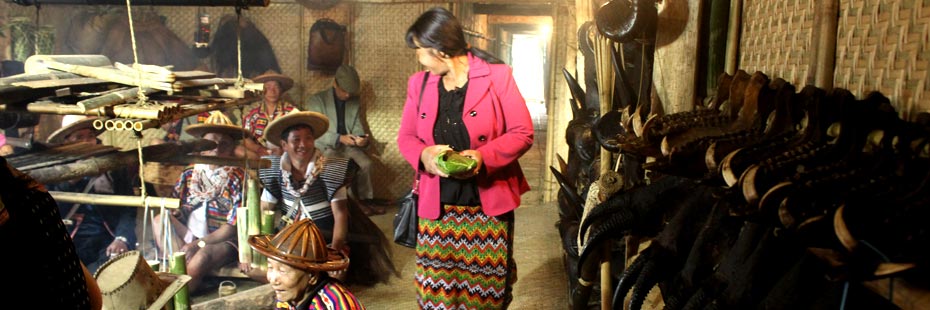
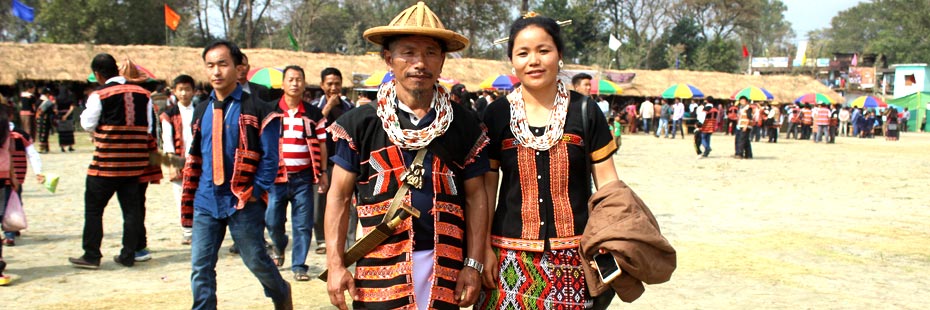
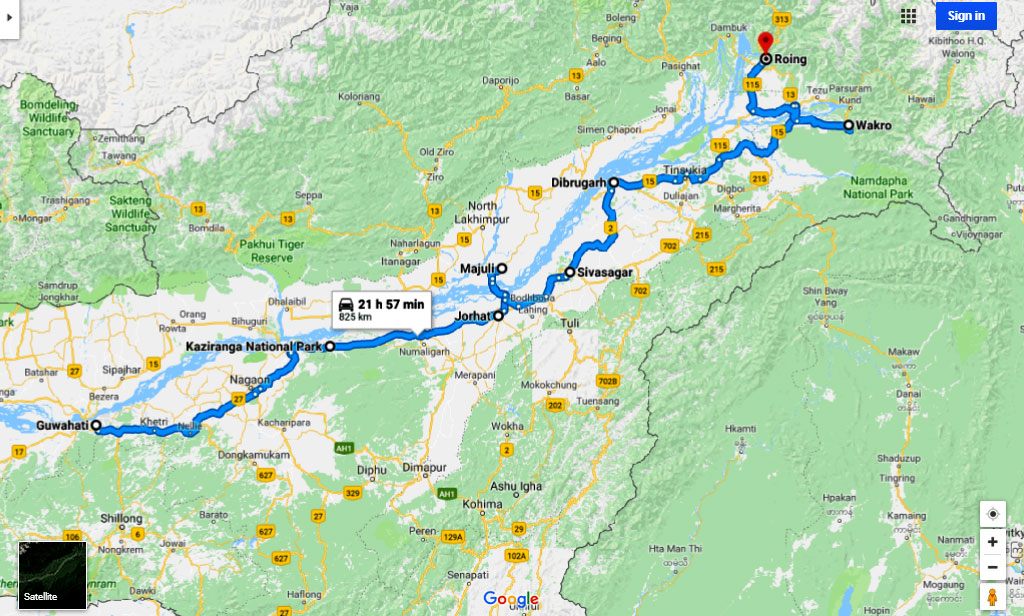
Reh is one of the most important festival of the Idu Mishmis who believe that they are the children of the divine mother 'Nanyi Inyitaya'. None can get her blessings and keep alive the bond of brotherhood and social feeling strong, unless one performs the puja or celebrates the Reh festival.
The Reh festival is generally celebrated for 3 days from 01st to 03rd Feb every year. The first day is called 'Andropu'. It is observed by offering prayers so that the festival may pass off smoothly. The mithuns are brought and tied near the house. The 'Naya' dance is held during the night. Eyanli is the second day and may be termed as the killing day of animals such as mithuns and buffaloes. The guests are entertained with rice, meat and rice beer. The third day is called 'Iyili' and on this day heavy feast is arranged and everybody is entertained. Presents of meal-rice are also supplied to the neighbouring villagers who fail to come to the festival.
Received at Guwahati airport and later drive to Kaziranga National Park (220 kms/ 04 ½ hrs). Check in at hotel for 02 nights.
Guwahati: Situated on the southern bank of the Brahmaputra River in the Kamrup District of Assam, Guwahati is a fast growing premier city. It is the gate way to the North Eastern States of India and a principal center of socio cultural, political, industrial and trade and commerce of the entire region. Dispur, the capital of Assam is a part of Guwahati. Earlier, this city was full of areca nut trees rappled by pan creepers. Hence this city subsequently got the name Guwahati. The word ‘Guwa’ in Assamese means areca nut and Hat means market.
Kaziranga national PARK a World Heritage Site, where more than 75% of the world’s total population of the great Indian One Horned Rhinoceros can be found. It lies on the southern bank of the Brahmaputra River and is one of the oldest parks of Assam. Besides rhinos, the Asiatic Water Buffalo, Elephants, Tigers, Swamp deer, Barking deer and Hog deer can be seen. About 400 species of birds are found in Kaziranga National Park. Swamp Francolin, Great Hornbill, Pallas’s Fish Eagle, Pied Falconets, Greater Adjutant Stork, Long Billed Vulture. There is no telling what one might find in Kaziranga but it is always a great experience. The specialty here is the Blue naped pitta among a host of Raptors and Waterfowl. The adjoining buffer areas are worth a try too, as numerous rare sightings are reported regularly.
We spent the full day exploring the beautiful forests and grasslands of the National Park with morning 01 Elephant Safari (Optional) followed by 01 Jeep Safari post breakfast. Post lunch enjoy another Jeep Safari. Overnight at the hotel.
Approximately 45 mins duration 05.15 PM to 06.15 PM & 06.15 PM to 07.15 PM
Elephant safari for foreign nationals are held only on Kaziranga Range, Kohora (Central Range) Allocation of elephant riding seats and timings are regulated by the forest department, Kaziranga National Park, Government of Assam. The tickets for the same are issued only on the previous evening of the ride after 7:30 PM. subject to availability.
It starts very early in the morning and continues for approx 45 minutes. It is the best way to explore the wide variety of wildlife in Kaziranga National Park. The park is covered by elephant grass which is very high and so the view from elephant back is perfect! During the course of the safari one can see herds of Indian Elephants, One-horned Rhinoceros at a very close distance. This proximity to wild animals in Kaziranga National Park makes the trip memorable and thrilling. The elephant safari takes place in the central range of the park and one gets good views of the rhino while traversing through its terrain of swamps and tall grass. It is also great for early morning photography of rhinos in the mist. There are good chances of seeing the Bengal Florican from elephant back.
Jeep Safaris are permitted on pre-defined tourist circuits within Kaziranga National Park- currently at the following four points. Each of these circuits takes about one and half to two and half hours (or even more depending upon interest of the tourists), subject to local range conditions and weather. Jeep Safari may be cancelled / curtailed due to any reason by the Park Authorities without prior notice.
The Central Range passes through the entire habitat spectrum from ox-bow lakes, savannah woodland to swamp forests. It is very good for mammal sightings as well as for birds (Blue-bearded Bee-eater, Great Hornbill, Rufous Woodpecker). While driving along the trail, one can see rows of Indian Roofed and Tent Turtles (Kachuga tecta and Kachuga tentoria). Water Monitors Varanus salvator are sometimes spotted in the beels.
The Eastern Range abounds in water birds such as bar-headed geese, falcated duck, grey-headed lapwing and spot-billed pelican (a colony of 200 pairs of this globally threatened species nesting on the Bombax trees can be found here).
The Western Range has the highest density of rhinos as this part of the park is swampier. It has grassland birds and raptors (swamp francolin, pallas's fish eagle etc ). Smooth Indian Otters ( Lutrogale perspicillata) can sometimes be seen fishing in it’s ox-bow lakes.
Today after breakfast drive to Dibrugarh (220 kms/ 04 ½ hrs). Enroute we visit the Ahom monuments and temples at Sivasagar which encompass the 600 year old history of the Ahom Dynasty. On arrival check in at hotel. Evening enjoy a dance performance by an ethnic dance group on the bungalow lawns at Mancotta Heritage Chang Bungalow. Overnight at hotel.
SIVASAGAR was once the capital of the Ahom Kings. The Shans who came from Thailand through Northern Myanmar to this area in early 13th century, ruled for 600 years. The Siva Temple, built by the Ahoms, situated here is believed to be the tallest of all existing Hindu temples. The ruins of the Ahom palaces and monuments dot the landscape around this historical town. Centuries, before the arrival of the British, this part of the world was controlled by a number of tribal chieftains.
In the town of Sivasagar, one can still see the remaining well preserved relics. The largest and the oldest ampi-theatre of Asia (Rang Ghar) is also another remarkable landmark in the history of Sivasagar. The Tai- Ahom Museum of Sivasagar contains some of the relics of the Ahom period like – swords, clothes, manuscripts and sundry artifacts.
Dibrugarh is the gateway to the “Hidden Land” of Eastern Arunachal Pradesh and Northern Myanmar. The Ahoms from Thailand came through Northern Myanmar to this area in the 13th century to establish their Empire which thrived in the ancient land of Assam. It is the “Camellia” town of Upper Assam, an undisturbed haven, with its rich tea gardens resembling a lush green carpet. Experience and enjoy the richness of these tea gardens while staying at the Heritage Chang Bungalows. These are constructed on stilts and are situated in a serene atmosphere free from pollution.
Bihu is the most popular folk dance of Assam. The people of Assam are very proud of its unique position among all other such dances of India. Except Bhangra (the popular folk dance of Punjab), no other folk dance in India can compete with the rhythmic exuberance of the Bihu dance. ‘Bihu’ performed by young men and women reflects youthful passion and joy rejuvenating life during the spring season, accompanied by songs woven around the theme of love and physical yearning. The dance is performed by all- irrespective of caste, creed and religion.
Post breakfast take a tea walk. Later we drive on to the river front and take a BOAT CRUISE on the mighty Brahmaputra river in a country boat (Subject to weather conditions). Cruise upto a beach island in the midst of the river. En-route there is a possibility of your sighting flocks of migratory water birds and the elusive Gangetic River Dolphin. Enjoy the view of the Eastern Himalayas and take a nature walk in the vast expanse of grasslands surrounding the island. Enjoy your picnic lunch and the view of the Eastern Himalayas. Option to take a nature walk in the vast surrounding the island. Return to the mainland. Afternoon option to visit local market. Overnight at the hotel.
Today early morning we drive to Tinsukia (01 hr) and later we explore Dibru-Saikhowa National Park and Maguri Beel. We take several boat rides on the Dibru River, go for a jungle walk, for a variety of bird sightings and the Gangetic Dolphin sightings. Overnight at the hotel.
Dibru-Saikhowa National Park has the most distinct and vibrant wilderness on earth and is known for its pristine scenic beauty. The forest in this park ranges from semi-evergreen to deciduous to littoral to swampy marshes with patches of wet evergreen jungles. Dibru-Saikhowa is a safe haven to many rare and endangered species of over 350 birds and is a must visit site for target-list birders. The big four here are Jerdon's Bushchat, Black-breasted Parrotbill, Marsh babbler and Jerdon’s bushchat. Several other rarely observed species can be found in its extensive grasslands, wetlands, and riverine forests. These include Baer's Pochard, Bengal Florican, Pale-capped Pigeon, Falcated duck, Baikal teal, Chinese spotbilled duck and Rufous vented prinia. Dibru-Saikhowa is a haven for an incredible number of waders ,ducks and raptors. It is well known for grassland birds.
Maguri-Motapung Beel – is in Tinsukia District of Assam. It is a wetland complex which is part of Dibru Saikhowa , and is located just outside the Dibru Saikhowa National Park and Biosphere Reserve. Maguri-Motapung Beel is located in the southern bank of the Dibru River, ‘Beel’ is the local name for a lake with marshy areas around it’s edges. The Beel is connected to the Dibru River by a system of channels and is very rich in aquatic life especially waterfowl and grassland birds.
Tinsukia - The ancient name of Tinsukia was Bangmara and was also originally known as Changmai Pathar. It was the capital of the Muttack Kingdom. Bangmara city was built by King Sarbananda Singha with the help of his Minister Gopinath Barbaruah alias Godha. The city was built originally in the middle of where the present Tinsukia city is situated (near Senairam H.S. School). As legend goes- Sarbananda Singha,asked Godha Baruah to dig a triangular shaped pond in Bangmara which is now known as "Tinikunia Pukhuri". In 1884 a Dibru-Sadiya Rail line was constructed, and a station was setup near "Tinikunia Phukhuri"- this was subsequently christened Tinsukia. Since then the city is known as Tinsukia.
Today early morning drive to Roing (2 ½ hrs) in the Debang valley of Arunachal Pradesh to witness the Reh festival. Later in the afternoon drive to Wakro (03 hrs). Check in at Mishmi Retreat, Wakro. (Traditional Mishmi huts) for overnight.
Roing rises from the Himalayan foothills to the middle ranges with the highest point of Mayodia at a height of 2655 meters from mean sea level. Snow-capped peaks, turbulent rivers, mystic valleys and abundance of rich flora & fauna are a few attractions of the district. The district is well known for its largest cover of thick green forest with almost 80% of the area being notified as reserved forest, wild life sanctuaries or unclassified state forests. Idu Mishmi is the major tribe inhabiting this area along with the Adi Padam tribe in the lower plain areas. The Idu Mishmi tribe is also known as Chulikatas. They build their houses on the slant of hills or in the forest .The roof is thatched with grass bamboo, timber etc. Their main festival is Reh. Their dress is remarkable for the wealth and beauty of its designs. Most of the dress is made by themselves from wood, partly from cotton and sometimes of nettle fibre. They also wear thick coats of black with white pattern made of nettle fibre and human hair.
The abundance of natural beauty, colorful and charming tribes, and ancient archeological sites make the place a perfect destination for nature lovers, adventurous tourists, archeologists and anthropologists.
Wakro (maximum valley altitude 2000m) is the homeland of the “Mishmis” one of the Mongoliod tribes of Tibeto-Burman origin. They speak their own dialect which varies from different groups. The three major Mishmi groups are “Idus” “Tarons” and the ‘Kamans’. Mishmis are very rich in culture and may be termed as a festival loving people. They believe any day of the year is auspicious for a ceremony if provisions exist. On these days animals are sacrificed. Mishmis are nature worshipers.
Mishmi Retreat : Surrounded by enchanting nature, this campsite comprises of four Mishmi traditional huts, each with two rooms one double bedded and one twin bedded. It can cater to a maximum group size of 16 pax. Four western toilets with provision of showers are not en-suite but conveniently located behind the huts. Hot water will be provided in buckets. There is a gazebo which provides for the common seating and dining area - an ideal getaway for the nature lover.
Today we visit the local Mishmi tribal villages to learn about their rich culture and traditions and interact with the Mishmi tribe. Later drive to Tinsukia (145kms/03 hrs). Enroute visit Golden Pagoda at Chowkham. On arrival check in at hotel.
Mishmi are the inhabitants of Lohit Districts and the border area of adjoining district. Mishmis are animist and believe in a number of higher spiritual beings. Kabeya, or Pharai in their traditional village council who exercise the judgment of any disputes comes to their society. The Mishmi society is divided into numbers of sub-tribes such as Idu -Mismis, Digaru Mishmi, Miju Mishmi with more or less distinctive characters on its dresses among themselves. This tribe can be easily distinguished from other by their typical hairstyle
Their dresses reflect the artistic taste and the cultural thinking of the society. The male dress of Miju and Digaru consist of a sleeveless black or maroon coloured cloth with ornamental boarders and waist cloth with a embroidered flag in the front. They wear a head dress of woven cane. The women wear black skirts with coloured stripes reaching above the ankle and a beautiful embroidered bodice and a shawl. They also wear beautiful ornaments made of silver. The women keep themselves busy in weaving. The men are involved in making cane and bamboo products. The puffing of opium with the help of silver or wooden pipes by both men and women is the part and parcel of their tradition. These people may be termed as festive tribe. Reh is the most important festivals celebrated by Idu-Mishmis during 1st week of February.
Golden Pagoda at Chowkham: It is a beautiful Buddhist Pagoda well located near Tengapani River Foot Bridge. Close to it one can also see a Buddhist Vihara (Temple ) with an image of the Sleeping Buddha.
Today post breakfast we visit Namphake Village and Digboi, the first oil town of South Asia. Visit the Oil Museum and the 2nd World War Allied Forces Cemetery where 200 graves are permanently maintained by the Commonwealth War Graves Commission. Thereafter drive to Dibrugarh (01 hr). On arrival check in at hotel.
Namphake is a beautiful ‘Tai’ village situated on the banks of the river Buridihing in Upper Assam.At Namphake one can see traditional houses built on stilts made of bamboo. Their roofs are made of ‘tokou pata’ (fan palm leaves).The Tai-Phakes are Buddhists, who have maintained their traditions and customs, and wear hand woven clothes. They weave beautiful mekhlas and bags of various designs. The people are very hospitable. The Buddhist monastery at Namphake is well maintained and is worth a visit.
Digboi, the first oil town of Asia, is believed to have derived its name from a command- "dig-boy-dig!"- given by the original explorers to their laborers to dig when they found traces of oil in this area. Digboi takes pride in having the second oldest oil refinery in the world which is still partially operational and it also has the distinction of establishing the first oil museum in India. Its 18 hole golf course is an added attraction which lies adjacent to the Upper Dehing Reserve Forest. This golf course is known for its scenic beauty. A visit to the nearby 2nd World War Cemetery and the centenary park offers a unique experience.
N.B.- Digboi museum remains closed on Monday of the week.
Post after early breakfast experience a tea tasting session of different types of tea with a knowledgeable person in the field of tea / practicing estate manager, followed by visit to Mukul TE which specializes in organic green tea. Later in time transfer to Dibrugarh airport to board flight for onward destination.
Mukul Tea Estate has an area of 27hectares and is about 8 Kms (approx 30mins) away from Mancotta Heritage Chang Bungalow. The entire garden which is organic, is located within pristine surroundings. The estate, has within its boundary, a tea plantation, a rich bamboo stand and a wet land which attracts numerous bird species. Visitors can enjoy a firsthand experience of plucking tea by hand and preparing roasted green tea themselves.
Note: Visit to tea factories is subject to being operational on the day of the visit. There is no tea plucking between December and mid-March and hence the actual manufacturing processing of tea cannot be demonstrated when one visits the factory during this period. Factory also remains closed on Monday’s of the week.
Our package rate for the above itinerary (08 nights / 09 days) on full board basis valid until 10 Feb 2019
Rs. 89000.00 per pax on twin sharing
Single room supplement: Rs. 25000.00 per pax
Foreign Nationals would require Protected Area Permit (PAP) to visit Arunachal Pradesh. The same is issued for a minimum group size of 02 or more pax travelling together. Following documents are required to process the permit (PAP). The documents may be scanned and forwarded by email.